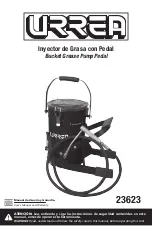
Inst339 Filtrite Salt Chlorinator V09.20
11
CHLORINATOR MAINTENANCE AND TROUBLESHOOTING
If the supply cord is damaged, it must be replaced by a qualified person in order to avoid a hazard.
Cell Maintenance
Your Filtrite chlorinator has an automatic cleaning feature that under normal conditions, will keep the cell plates clear of
deposits of salt and calcium. In certain circumstances and with unbalanced water, calcium build ups can occur which will
require manual cleaning of the cell.
Filtrite chlorinator cells have a negative charge sensor that monitors the flow and salt levels of the water. This sensor is
designed to be a failsafe. As it is negatively charged, deposits of calcium or other debris may build up on it and cause it to
indicate a low salt or no flow condition. Should a low salt condition be indicated, have your salt level checked at your local
pool shop. If the low salt condition persists, or a no flow condition is indicated when the supply pump is operating, you may
need to manually clean your chlorinator cell.
Cell Cleaning Instructions:
(a)
Close applicable valves
(b)
Disconnect the
chlorinator from the mains power supply by removing the 3 pin plug
(c)
Disconnect
the cell wires
(d)
Undo
the barrel nuts connecting the cell to your filtration system.
(e)
Turn
the cell upside down (inlet and outlet on top) and fill the cell with Filtrite Salt Cell Cleaner.
(f)
Repeat
if necessary and then rinse well in clean water
(g)
Re-install
the cell ensuring o-rings are correctly located and barrel nuts are tightened to prevent leaks
(h)
Re-connect
cell wires with wing nuts supplied making sure the blue wire is connected to the blue terminal.
Incorrect connection may damage your chlorinator control. Ensure the electrical connection is sound.
(i)
Return
all valves to their normal positions, re connect power to the chlorinator and turn on at power point.
WARNING: Follow safety instructions provided with cell cleaning solution. Use of Hydrochloric Acid is not recommended
for cleaning of your Filtrite chlorinator cell as it may reduce the life of the unit and is dangerous to handle.


































